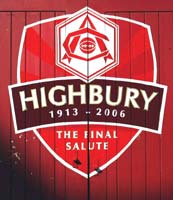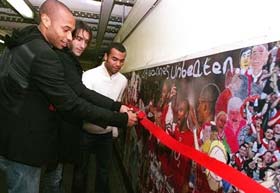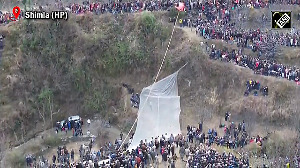Stand at the top of Highbury hill in north London and, at a glance, you can see how big money has transformed English football.
 Down Avenell Road lies Highbury stadium, home of Arsenal for 93 years and one of the temples of English football. Its art deco-style facade, still grand after all those years, stands guard over rows of terraced houses.
Down Avenell Road lies Highbury stadium, home of Arsenal for 93 years and one of the temples of English football. Its art deco-style facade, still grand after all those years, stands guard over rows of terraced houses.
Now look left and the future smacks you in the eye. The Emirates Stadium, partly funded by a Middle Eastern airline, dominates the skyline -- a gleaming architectural showpiece which will be home to the Gunners from next season.
For the first time, one of the giants of the English game is moving house, forced to sacrifice tradition for the increased revenue that a new 60,000-seater stadium provides.
Arsenal's game against Wigan on Sunday will be their 2,010th and last at Highbury before it is developed into apartments.
A choir of 38,000 fans will attend the requiem, their emotional attachment to the stadium almost as strong as their allegiance to the club itself.
"Highbury is a mini-world where all your experiences meld into one and you can barely distinguish one game from another," says Marc Sands, a season ticket holder for 19 years.
"It's an ever-present fixture in your life, a place to go which has no relationship with the rest of your life and where the memories are tied to only that place."
DIVINITY COLLEGE
 Arsenal, formed in 1886 by workers at the Royal Arsenal in Woolwich, south London, moved to Highbury in 1913, settling on the site of the playing fields of St John's College of Divinity.
Arsenal, formed in 1886 by workers at the Royal Arsenal in Woolwich, south London, moved to Highbury in 1913, settling on the site of the playing fields of St John's College of Divinity.
They arrived a relegated side with serious financial problems. Within 20 years they were the dominant force in the land, winning five titles in the 1930s.
These successes allowed the ground to be redeveloped. The West Stand was opened in 1932 and the famous East Stand four years later.
Protected from alteration under modern-day heritage laws, the red and white East Stand is a reminder of how football used to be with its marble halls, bust of 1930s manager Herbert Chapman and military-style commissionaires to keep out the riff-raff.
Executive boxes were added to the Clock (South) End in the late 1980s and in 1993 the North Bank was completely redeveloped as Highbury became an all-seater stadium, sharply reducing attendances which had peaked at 73,295 in March 1935.
Despite all the changes Highbury, unlike Manchester United's Old Trafford ground or Chelsea's Stamford Bridge, still looks and feels like an old-style football cockpit with the seating finishing just a couple of steps from the immaculate pitch and the brick-lined, echoing stairways to the stands.
Every day tourists can be seen leaving the Arsenal underground railway station on a pilgrimage, needing help from locals because the ground hides itself well among the houses.
"When you arrive for the first time at Highbury the stadium is suddenly in front of you and you don't know (how) because on the continent you see a stadium from three miles away," Arsenal manager Arsene Wenger said recently.
"What I always like in England is that you feel the club belongs to the population who live around there. I like the idea that you can go out the door and go to a football game.
"That doesn't exist anywhere else."
LEAGUE TITLES
Arsenal have won 13 league titles during their time at Highbury and the stadium has also hosted internationals, served as a first aid post during World War Two and hosted the 1966 world title fight between Muhammad Ali and Briton Henry Cooper.
It was the venue of the first radio commentary on a football match in 1927 and the first televised game 10 years later.
Highbury was also the centrepiece of a 1930s film "The Arsenal Stadium Mystery", which revolved around the poisoning of a player, and Nick Hornby's "Fever Pitch" book which captured a fan's fervour as football's popularity exploded in the 1990s.
In 1991, on the day Arsenal clinched the title, you could buy a ticket at the box office and wander into the Clock End. Nowadays, tickets for Highbury are like gold dust unless you are a season ticket holder.
Other Premier League clubs, such as Manchester United, expanded or built new, bigger stadiums as television money flooded into the game. This left Arsenal at an ever-widening financial disadvantage - United take in around 20 million pounds a season more in match day revenue.
Local opposition to the North Bank redevelopment meant expansion of Highbury was out of the question and Arsenal finally picked Ashburton Grove, a large area of light industrial buildings just around the corner, to site a new stadium.
The club is trying to ease the pain of departure. They have run a series of Highbury-themed matchdays this season and will stage a series of auctions where you can buy one square-foot pieces of the pitch, or Highbury memorabilia and equipment.
Season ticket holders can also purchase their Highbury seats. Sands will buy his and is already looking forward to walking through the gates of the Emirates Stadium.
"It's an astonishing stadium -- Highbury was quite uncomfortable and had restricted views," he admits.
"The fact the stadium is in the same neighbourhood means Arsenal will not lose its sense of being a gritty, north London club. The fans' routines will be exactly the same.








 © 2025 Rediff.com -
© 2025 Rediff.com -